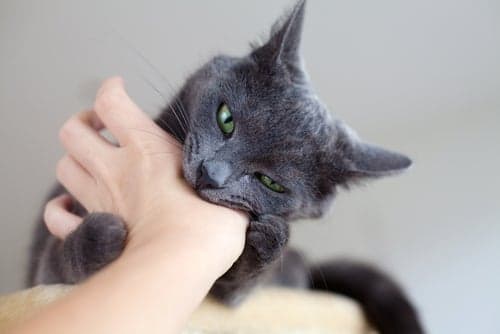When wanting to solve problems with your cat’s behavior it is important to be realistic and patient. You should not pressure your cat, because you may feel frustrated because you may think that it is not up to your expectations. You can follow any of the following guidelines, but don’t expect the cat to necessarily change to your needs. If your pet bites it is for some reason.

Reasons that influence your cat to bite
There are several reasons why your cat can bite you. For example, if you get scared or feel threatened, you will naturally try to defend yourself .
Before you bite you can perceive certain signs that he will do it. Watch your cat’s body language when it is overstimulated or irritated. Normally they usually flatten and turn back, while they will turn to face, their tail will begin to whip. At this time you can throw a swipe with the claws or bite.
For a cat, there is a very narrow line between a pleasant caress and irritating handling. When your pet doesn’t want you to follow anymore, the only way he has to tell you to stop is with his claws or his teeth. Also, if you touch it in a sensitive area, it can tell you to move away from that area that way.
If your cat has spent all his life in a quiet place and is suddenly tormented by children who make noise or mischief, your cat will probably defend himself by biting.
Training to prevent a cat from biting while playing is just as easy for both adult and small cats. However, educating a cat so that it does not bite when scared or angry is easier at an early age.
If you have an adult pet that has been biting for years, it will take some more time and energy. This should not be something that discourages starting the training. Many adult cats learn to accept situations without reacting aggressively, you will only need more time and patience.
Training for your cat to stop scratching and biting

Game sessions offer the best opportunity to teach cats not to bite or scratch. It is in the game where you can perceive if your cat attacks even without being angry or scared. They bite and scratch playing because they are developing their hunting instincts. That’s why in the game you can teach your pet to be careful and gentle. Teach him to play with his legs, not with his claws or his teeth.
Start by inviting your kitty to a fighting game. When he is playing softly, encourage him with words. Gradually increase the intensity and emotion without separating the sight of your cat.
As soon as you see that your pet shows the claws or teeth, lower the intensity or stop the game immediately. This usually causes him to calm down and retract his claws. If that happens, resume the game. If not, you must start the game once the cat is completely calm.
If in the game the animal bites you or spider you exaggerate shouting “oh”, interrupt the game immediately and leave calm without paying attention.
Kittens love to play. If you end a game session abruptly, you will give a very powerful message to your pet. With few repetitions, your cat will learn that his behavior is very rough and very aggressive, which will surely soften to continue the game.
While the cat is learning not to bite or scratch it is very important that you provide a toy to which you can “attack” because his hunting instincts will focus on the prey and not on you.
Although you have your pet with all the comforts in your home, you should not forget that cats are predators with a strong hunter instinct. It is normal for cats to use teeth and claws to develop their instincts, so you should give it a natural way out with a toy or your cat will practice with your legs or your hands.
If you leave some toys on the floor, your pet will give them a couple of swipes and quickly lose all interest. It is up to you to have fun with the toys, it must be an interactive game between you, the toy and your cat.
One way to do this is to “animate” the toy by tying it with a thread to the tip of a stick so you can move it and your little friend will follow it. Look at pet stores for toys that you think maybe interesting to your cat.
